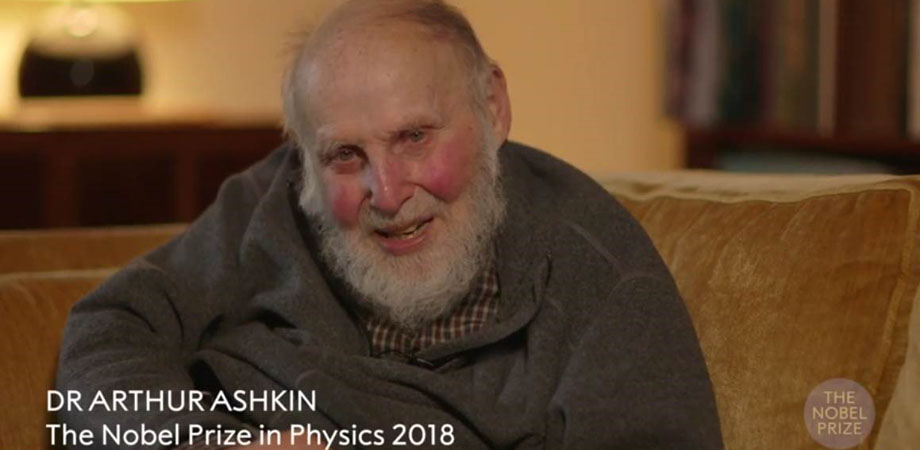Celebrating Arthur Ashkin’s Nobel Prize

At 96 years young, Nobel Prize winner and SPIE Fellow Arthur Ashkin is no longer attending conferences. But his legacy is alive and well at SPIE Optics + Photonics, where he was honored with a special session celebrating his achievements in optical trapping. The session was organized by Gabriel C. Spalding, professor of physics at Illinois Wesleyan University, and Kishan Dholakia, professor of physics at the University of St. Andrews. Dholakia, who is a quantum physicist by training, was introduced to Ashkin's work on optical trapping early in his career, and went on to become a leader in novel optical manipulation techniques.
The invited speakers reminisced about the tremendous impact of Ashkin's research on their own careers and scientific contributions. Michael Berns, cofounder of the Beckman Laser Institute and Medical Clinic, recalled inviting Ashkin to visit his lab in 1988, where Ashkin showed Berns' graduate student Bill Wright how optical traps work. Berns, thinking this was a monumental assignment, asked Wright to give him a call as soon as he had a working optical trap. To his surprise, at 2 a.m. that same night, he got a call from Wright letting him know that the trap was working.
Soon after, Berns' group was able to use optical tweezers to move chromosomes inside of a cell, which was a first. They were also able to trap a sperm cell, then gradually reduce the optical restraint until it could break away from the restraining force. They used that information to calculate the force with which a sperm cell moves. While that application may sound silly, they subsequently used that information to study sperm competition and motility in primates, and they tested the hypothesis that sperm from polygamous primate species (macaques) swim faster and with greater force than sperm from polygynous primate species (gorillas). Their optical trapping technique supported the hypothesis. And, if you're curious, human sperm motility is somewhere between that of gorillas and macaques.
Halina Rubinsztein-Dunlop, professor of physics at the University of Queensland, Australia, shared her own recollections about how she met Ashkin and entered the field of optical manipulation. When she got started in optical trapping, a lot of experiments had already been done, and she wasn't sure how to enter the field. She thought, "Everyone is trapping transparent particles. What if we trap absorbing particles instead?" After doing the experiment, her graduate student found that the trapped particles were rotating, which was new and unexpected. They published a landmark paper explaining this spinning phenomenon, which occurred in response to optical angular momentum of the beam being transferred to the trapped absorbing particles. Rubinsztein-Dunlop had entered the field in her own right. This discovery launched a unique line of inquiry into the way that particle spin can be harnessed to manipulate larger structures, such as neurons.
In spite of Rubinsztein-Dunlop's own significant contributions to the field of optical manipulation, she insists that Ashkin had foresight into the lines of inquiry she would ultimately pursue. "Everything that we're working on and talking about today, Ashkin had already thought of it. He may not have done experiments yet, but he had the idea." She gave the example of optical trapping in a vacuum—a hot topic in 2019—which Ashkin was talking about in the late 1970s.
In addition, Ashley Carter, Amherst College, described her journey into the field of optical tweezers with a particular emphasis on the excitement of this approach. She described how the method allowed a new way to look at biophysics, particularly the mechanical properties of single biological molecules and cells. The session ended with a talk from Grover Swartzlander, University of Rochester, who described how laser-driven sails and the use of radiation pressure provided new approaches for in-space propulsion.
Ashkin's pioneering studies of optical trapping opened up a remarkable breadth of significant new interdisciplinary fields where his innovations in photonics have played a central role. This has included a profound impact on the study of biological systems. Spalding and Dholakia, co-chairs of the Optical Trapping and Optical Manipulation Conference at Optics + Photonics, carry on Ashkin's legacy. The popular conference is now in its sixteenth year, and the nanophotonics community looks forward to the next sixteen years of discoveries.
Related SPIE content:
2018 Nobel Prize in Physics: Lasers Rule!
Photonics Ecosystem Takes Nobel-winning Technologies to Market
| Enjoy this article? Get similar news in your inbox |
|



